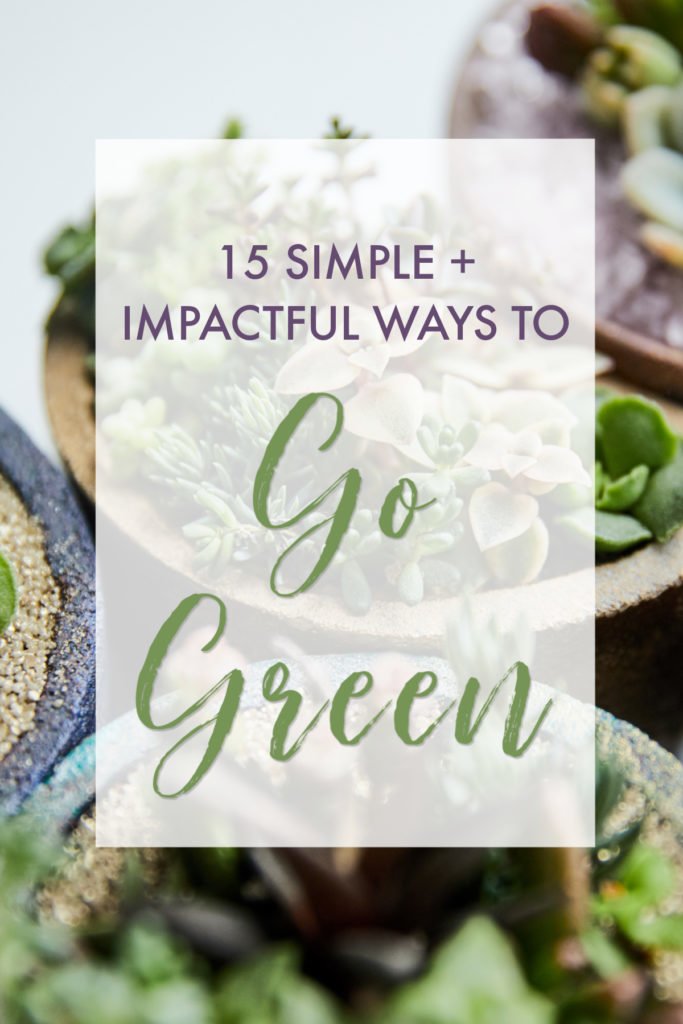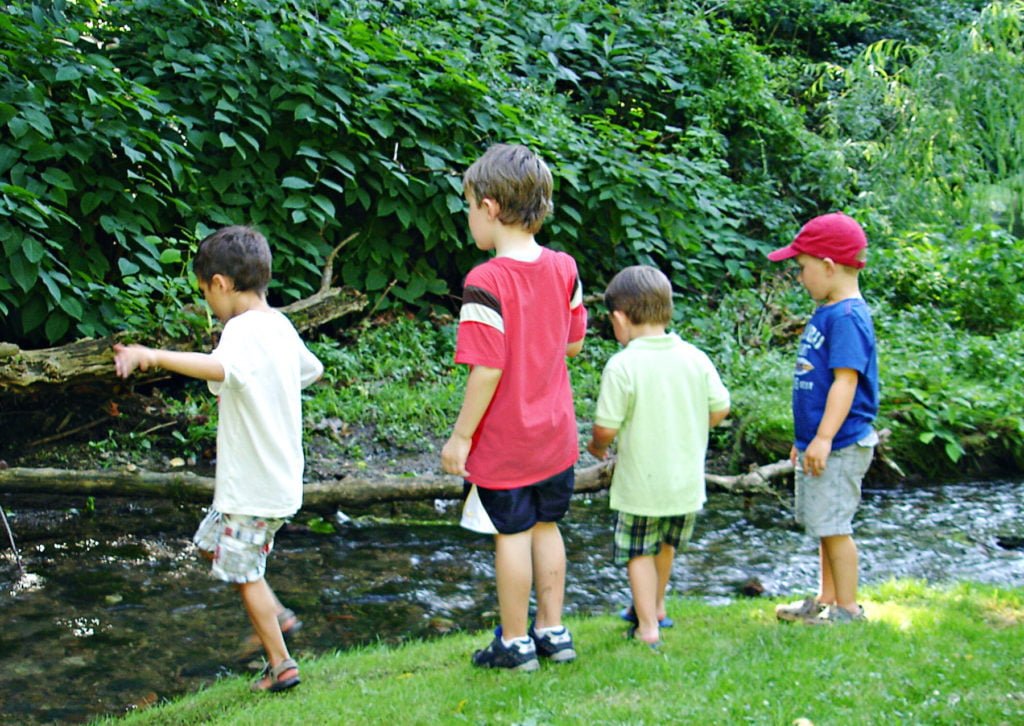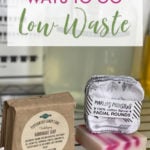How to Go Green: The Top 15 Most Important Sustainable Steps
Over the past decade, we’ve published nearly 200 articles on how to go green and live a low-waste lifestyle. Because some are hard to find, we’re rounding up all those articles on going green… plus giving you some tips right here on the most impactful ways to make a sustainable difference.

So, here’s where you’ll find everything from beginner (quitting the bottled water habit) to advanced (working toward a zero waste or low waste home) plus the 15 most important steps for creating less waste and using fewer resources.
Why is Going Green Important?
Sometimes it’s disheartening to look at the state of our planet. And it’s hard to know if our individual changes really make a difference. But the truth is that every positive action has a positive impact.
Embracing a low-waste lifestyle is important for many reasons. The obvious benefit is that it leads to less pollution and fewer resources used. But there are many other benefits like saving time and money, encouraging healthier eating, avoiding exposure to toxins, and challenging ourselves to be more resourceful.
It also sets a great example for your child.
You do your best to live lightly on the planet. You’re kind to Mother Nature and are grateful and careful with her resources. And you give your child plenty of opportunities to get outside and fall in love with their natural surroundings.
After all – we protect what we love. So, with that in mind, let’s get into our top ways to go green.
15 Ways to Make a Difference for the Environment
Going green means different things to different people. While some can completely embrace the zero-waste movement, it might feel unattainable or stressful to others. Our team discusses green guilt often, and we feel most balanced with a low-waste (rather than zero-waste) lifestyle.
We certainly make conscious decisions and choose to support companies that are ethical and sustainable. But we don’t stress out over the occasional fast food wrapper or the fact that our kids love LEGOs (though we’re pretty excited for their transition into plant-based bricks).
Here are some beginner, intermediate, and advanced green choices you can make in your home. Choose a few of these steps and add them to your green routine this year.
Reduce What You Consume Overall
Of the 3 R’s (Reduce, Reuse, Recycle) Reduce is the most important.
You might think you’re not contributing to ocean trash because you’d never litter at the beach, but have you looked at what’s floating around out there? It’s not just plastic bottles, toy beach shovels, and grocery bags. There are also laundry detergent bottles, balloons, large yogurt containers, and milk jugs.
Those thousands of items most likely fell off a barge on their way to China to be recycled. And who knows how long they’ve been there, because China stopped accepting our recycling a few years ago. Placing an item in your recycling bin is no guarantee it actually gets recycled.
Reducing – or swapping your disposables for reusables – what you consume overall is the best solution. You’ll see echos of this in all of the tips below.
Stop Buying Bottled Water
Unless there’s some kind of contamination crisis, avoiding plastic water bottles is the simplest way to reduce waste. Bottled water has been found to contain contaminants and when analyzed, many brands are no better than tap water.
The production of plastic water bottles requires up to 17 million barrels of oil each year. Each bottle can take up to one thousand years to decompose, leaking dangerous and harmful chemicals during the process. Some toxins leaked could cause cancer and reproductive disabilities.
The argument of “but I recycle my water bottles” isn’t very convincing since only 12% of the annual thirty-five billion bottles used gets recycled, indicating that only half of what you place in a recycle bin actually gets recycled (source).
Avoiding plastic water bottles isn’t hard. In fact, humans did it for our entire existence up until the last few decades. All you have to do is drink water (filtered if you prefer) from a glass at home and keep a reusable bottle for when you’re on the go.
Even in many emergency situations, you don’t need to buy cases of plastic water bottles. Part of our team is in Florida, and during hurricane season we know our Big Berkey water filter is capable of filtering rain water, pool water, or water we’ve run in the bath tubs, buckets, pitchers, etc. prior to the storm.
Use Reusable Shopping Bags Instead of Plastic
This tip is near the top of every list of the things you can do to go green, because it makes a HUGE impact. Billions of plastic bags are used each year around the world. Plastic bags start out as fossil fuels and end up as deadly waste in landfills and the ocean. Birds often mistake shredded plastic bags for food, filling their stomachs with toxic debris.
For a hungry sea turtle, it’s nearly impossible to distinguish between a jellyfish and a floating plastic bag. Fish eat thousands of tons of plastic a year, transferring it up the food chain to bigger fish and marine mammals (source).
Reusable bags are often handed out at events or fundraisers. Sometimes they come with items you buy. You can probably create a collection of them without spending any money. That’s what we’ve done with the exception of our insulated bags. We bought one from Trader Joe’s that lasted nine years.

Make Simple Sustainable Swaps
While plastic water bottles and grocery bags are the biggest offenders, there are other swaps that make a huge difference. Every room in your home has opportunities to stop using disposables and switch to reusables.
Reusable straws instead of plastic
Plastic straws are one of the top items found during beach cleanups, and they often end up in the ocean where they can harm marine animals. Sea turtles, birds, and other wildlife can mistake them for food or become entangled, leading to serious injury or death.
Whether at home or when you’re ordering a drink at a restaurant, plastic straws are an unnecessary single-use item. Do without, or buy a set of glass, bamboo, or stainless steel for home and use the carrying case for travel. You can find reusable straws at your local health food store, plastic-free shop, or online.
Reusable on the go cups instead of disposable
We’ve been using the Joco glass cups with silicone lids and sleeves for about 12 years now. It has held up to tons of use. Many restaurants will refill them. But as you probably know, it’s cheaper and healthier to make your coffee or tea at home.
If you have to use a disposable cup, paper is greener. But some paper coffee cups have plastic lining and most have plastic lids.
Ditch the single use coffee pods
There are enough of these in landfills to circle the globe numerous times. Even the creator of the k-cup regrets their environmental impact (source).
If you still use a Keurig, get a reusable stainless steel pod replacement. Or make your coffee the old-fashioned way and use an organic hemp coffee filter or with a Chemex pour over coffeemaker and your tea on the stovetop with a safe kettle.
Tea pods made for Keurigs are equally wasteful. Tea bags are better, but there can still be a health hazard because many tea bags contain microplastics. Skip the plastic altogether and buy loose leaf tea in a stainless steel container. A stainless steel tea infuser eliminates plastic contamination and the need for straining. Pour hot water into a tea mug and steep with loose leaf tea in the infuser for 3 to 5 minutes.
Single use cleaning products
Most conventional homes are stocked with a variety of cleaning products that not only take up valuable space and cost a small fortune over time, but also contain ingredients that can pollute indoor air and irritate sensitive systems.
Many of these chemicals have been linked to respiratory issues, hormone disruption, and other health concerns (especially for babies and young children whose bodies are still developing).
Don’t throw them all out today, but once you’ve used them, save the bottles and make your own cleaners.
Soaps and shampoo
Switching from bottles of body wash to bar soap is easy and affordable. Do it and don’t look back. A few years ago, I started making my own soap with olive oil, lye, salt, and essential oils.
Shampoo and conditioner bars are another way to work toward a low waste bathroom. They save so many plastic bottles from landfills!
Reusable paper towels and cloth napkins
Reducing single-use waste in the kitchen is simple when you replace paper products with reusable alternatives.
Swap disposable versions of these for cloth napkins (buy them affordably or used or make your own) and un-paper towels.
Toothpaste
You can go plastic-free with your oral care items by choosing tooth tabs (packaged in cardboard or glass) or dental lace instead of floss.
Choosing a recycled content or bamboo toothbrush also helps you go green.
Diapers
Conventional diapers will sit in landfills for up to 5 generations. While nontoxic disposable diapers are better for baby’s skin than plastic, they’re still going to landfills.
Cloth is definitely the greenest choice. You can find out more about the basics of how to use cloth diapers here.
Menstrual products
Another way to reduce your waste and cost is to go reusable for your period. This calculator from Period Nirvana takes your age and flow to come up with how many disposables you can save from the landfill every year by switching to a reusable option.
Menstrual cups and discs are reusable and safer for your body. We’ve used them for 15 years, and our favorites are the Saalt Soft Menstrual Cup and Hello Disc.
Other standbys or backups for your cycle are period underwear and reusable menstrual pads. Find more about the health and environmental benefits of cloth menstrual pads here.
Gift Wrap
While not an everyday item, gift wrap and gift bags can really pile up during the holidays. There are so many creative and low waste ways to wrap gifts sustainably or make your own fabric gift bags with this tutorial.
Choose Paper or Cardboard Over Plastic
Generally speaking, it’s easier to recycle cardboard than plastic. Plus paper products tend to break down more easily without adding a lot of weight to the product the way glass or aluminum can.
When you have the choice, pick pasta in the box instead of pasta in a bag, or laundry detergent in a box instead of the plastic bottle. Even better – check for companies that source their cardboard sustainably or take a strong stance on deforestation.
Eat at Home and Reconsider Your Food Storage
Cooking at home with fresh ingredients is a huge way to reduce your impact. Buying food at your local farmers market or CSA typically means no packaging waste, plus you’re supporting the community.
Eating more vegetables and fewer factory-farmed meats helps reduce greenhouse gases. If your family eats meat, try decreasing your serving sizes and letting the vegetables take center stage on your plate. When you purchase meat, be sure to buy it from a reputable grass-fed source without hormones or antibiotics.
Not only is eating at home healthier and more affordable, fast food and take away containers add to tons of single-use waste. Often they are plastic or styrofoam and can contain endocrine disruptors – namely phthalates.
Even though phthalates can be found all around us, diet is now considered a major cause of exposure to this chemical — especially when that diet is mostly comprised of fast food. People who eat out more often were found to have phthalate levels 35% higher than people who eat meals prepared at home.
Plastic baggies, plastic wrap, and plastic storage containers aren’t ideal from a food safety standpoint, and they’re certainly not good for the planet. Here’s an easy guide to storing fresh foods plastic-free. There are plenty of great glass storage containers, beeswax wraps, and silicone bags and containers that are food-safe and reusable. And you might be surprised at all the ways you can use (and reuse) mason jars in the fridge and pantry.
Conserve Energy and Water
As the World Wildlife Fund explains, many of the ways we get our energy — whether we’re supplying power to our homes or fuel to our cars — are dirty and wasteful. One way to cut back on your family’s carbon footprint is to make energy conservation a priority.
Kids can help with conservation, too. Playing outside instead of watching TV or playing video games, always turning lights off when leaving a room, and more — are easy habits for kids to develop and great ways for them to contribute to making the family more environmentally friendly. You can also make them the electricity monitor of the house with an energy saving checklist.
Here’s also how to talk with your kids about climate change without overwhelming or scaring them.
Running a few laundry loads a day can very quickly add up to a lot of wasted water (plus a lot of money for the water bill). It’s helpful to make it a rule not to run the washing machine until it gets full.
Choose energy star rated replacements when one of your appliances can’t be repaired. Check online to see if renewable energy is available from your local utility provider. Some states offer solar energy incentives.
Vote
Your state and local representatives are hearing from special interest groups and big businesses with big money. They need to hear from YOU. While there are several steps you can take in your home, you can’t possibly pollute or waste resources on the same scale as a large factory or corporation.
Here are a few ways you can voice your concerns and ask that corporations are held to sustainability standards that protect our planet and keep our environment clean and safe:
- Write a letter to the editor of your local paper
- Attend the city council meeting
- Find your representatives at CallMyCongress.com. Go to their websites, join their newsletters, find out where they stand on issues you care about.
- See the Get Involved: Index of Organizations list of nonprofit organizations, by topic, that are working to create fundamental change by educating the public and engaging citizens in grassroots initiatives.
Borrow or Buy Used
Need an item for a one-time project? Don’t buy it brand new. Find a way to rent, borrow, or buy it used. If you know your neighbors, consider going in on items like tools and lawn equipment to share.
And of course, get books from your local library. If you set up an account online, you can request books and only make the trip when they notify you the book is available. Or try the Libby app to listen to thousands of audiobooks or borrow ebooks for free with your library card.
If there’s a stigma in your mind about borrowing or buying secondhand, let it go. You can find practically brand new clothes at consignment stores because loads of people don’t want to be seen wearing the same thing twice in their social media feed.
We buy most of our furniture secondhand with the exception of mattresses (because yuck) and couches (because pets can usually smell previous pets and might try to mark their territory).
Plant a Garden
“The greatest change we need to make is from consumption to production, even on a small scale, in our own gardens,” said Bill Mollison known as the father of permaculture. “If only 10% of us do this, there is enough for everyone.”
Try your hand at gardening with the 10 Easiest Vegetables to Grow from Seeds. You won’t have to make as many frequent trips to the grocery store if you plant vegetables and fruit trees in your very own backyard.
And your family will love all those freshly grown organic foods!
Compost Your Food Waste
According to the EPA, nearly 22% of solid waste that enters the landfill is food. Composting your food waste is easier than you think. Collect your scraps in an old container or bowl on your countertop and then set up a compost pile.
Opt Out of Junk Mail
In the book Garbology: Our Dirty Love Affair with Trash, Edward Humes states that the energy used to create and distribute junk mail in the U.S. for one day could heat 250,000 homes.
There’s so much waste involved in the printing and transportation involved in getting it to you. It’s also mentally taxing to deal with it – especially once you’ve let it pile up. And it can be tricky to recycle because you probably don’t want credit card offers sitting in the top of your recycling bin on the street.
To opt out of most junk mail, go to optoutprescreen.com (scroll down to select opt out) to reduce how much that gets sent to you. You can also try to contact the company sending the mail and ask them to to remove you from their list.
Choose Greener Transportation
The Union of Concerned Scientists points out that our cars and trucks make up “nearly one-fifth of all U.S. emissions.” Naturally, one of the best ways to cut down on your family’s contributions to this pollution is to park the car and walk or ride a bike whenever the option is viable.
Walk or bike your children to school or to friends’ houses. Take public transportation when possible, and when the time comes to buy a new vehicle, buy the most efficient car you can afford.
Don’t Use Lawn Chemicals
The EPA considers runoff from lawn chemicals a non-point source of water pollution. When it rains, the excess chemicals run off into streams and lakes. These chemicals can get into our drinking water. The nutrients that promote grass growth also cause algae and pond weeds to grow. It creates a cycle that can affect food quality and the habitat for fish and other organisms.
There are ways to get a green lawn without chemicals or pesticides. Don’t go overboard worrying about weeds. Plant trees and landscape with native plants that don’t require a lot of extra water and fertilizing for your area.
Connect with Nature
As we mentioned at the top – we protect what we love. Connect with nature so you’re fully aware of WHY you’re going green. Walking barefoot in the grass helps offset our exposure to technology. Looking up at the stars or standing at the edge of the sea reminds us of the wonders and vastness of the universe. Hiking into a forest allows us to breathe deeply and forget about the busy-ness of life.
Spending more time outdoors nurtures our “nature neurons” and our natural creativity. For example, at the University of Michigan, researchers demonstrated that, after just an hour interacting with nature, memory performance and attention spans improved by 20 percent. In workplaces designed with Vitamin N or nature in mind, employees are more productive and take less sick time.
Another study of nearly one million Danish people taken across three decades found that “children who grew up with the lowest levels of green space had up to 55% higher risk of developing a psychiatric disorder independent from effects of other known risk factors.” (source)
More Information to Help You Go Green
Here are our most popular articles to help you along your green living journey:
30 Simple Ways to Reduce Your Impact on the Environment
10 Ways to Reduce E-Waste
Kids Who Spend More Time in Nature Become Happier Adults
The Dangers of Endocrine Disruptors & How to Avoid Them
10 Things You Can Recycle at Home
10 Reasons Children Need Vitamin N
Why & How to Raise Earth-Conscious Kids
10 Ideas for Celebrating Earth Day Outside
How to Host an Eco-Friendly Birthday Party
How to Wrap Gifts Sustainably
10 Eco-Friendly School Fundraising Ideas
How to Find Safe Plastic Toys
Plastic Seas and a New Generation of Problem Solvers
The Environmental Benefits of Remote Work
Plastic in Tea Bags & How to Avoid It
How to Avoid PFAS in Tea Bags
How to Protect Your Family from Pesticide Exposure
Whew! This has been a long one, but we’d love to hear from you. What steps have you taken or are you planning to take to make your home a little greener?




To tell the truth, I really like the message of your article because I think that it is really important to get closer to a sustainable future and create all necessary conditions for this. I absolutely agree with you that every positive action has a positive impact because each individual contribution is valuable. I think that if all people make a small contribution to going green and improving the state of our environment, we will achieve significant results because only cohesion can bear fruit. From my point of view, avoiding plastic water bottles is one of the most effective ways to change our reality because the negative impact of plastic is huge. In addition to harming the health of a living organism, plastic bottles have a bad effect on the ecological state as a whole. They pollute the ecology, water space and cultural recreation places. I really like your idea of giving preference to other modes of transport instead of a car because in this way you will be able to take care of nature to a great extent. Of course, it is not so easy in real life when you have a lot of duties, but I think you can always find an opportunity if you really want to.
There are several good hygiene tips. But I have never seen toothpaste packaged in cardboard or glass, can you name some brands and where I can find it?
Hi Lucia! You can find them at bulk or zero waste shops. Bite Toothpaste offers toothpaste tabs in recyclable glass bottles: https://bitetoothpastebits.com/